Our Farmers
from farm to shelf
We value transparency and working directly with our farmers to ensure the highest quality and freshest products possible. We vet each supplier to ensure they are contributing to the local economy and embody strong values, as each supplier is family owned with a purpose!
Medjool dates
Family owned date farm employing 80% working moms.
- 1 - Plant, Grow
- 2 - Harvest, Clean
- 3 - Pit
- 4- Fill, Pack
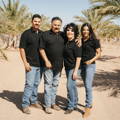
This family-owned date farm has been around since 1994, employs 80% working moms and has up to 70,000 palm trees in production.
The sustainable farm uses organic practices and is completely pesticide and additive free. They use an incredibly efficient drip irrigation system which can save as much as 80% of the water typically used in other irrigation systems. It also reduces energy consumption and has been proven to reduce greenhouse gases, including per-yield soil carbon dioxide emissions by 59% on some crops (Source: ScienceDirect).
To produce fruit, the male palm tree's pollen is required for the female palm trees to birth offshoots that give us fruit (flowers). Each palm tree can take up to 5-7 years to receive any substantial crop after being planted, and we don't know the sex of the date palm until they're 4-5 years old.
Each fresh (not dried) date is delicately hand picked with special care to ensure peak ripeness. Then, they are transferred to the packing facility located right on the farm.
While all Medjool dates are fresh fruit, some dates may be left out in the natural warm sunlight to slightly (but not fully) dehydrate and offer the perfect consistency and level of sweetness.
The dates are then cleaned, brushed and hand-sorted by size, ripeness and moisture content.

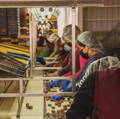
Because of the super soft consistency of the Medjool date, each date is carefully hand pitted.
The pits are then put aside and upcycled for soil fertilizer, date seed coffees, animal feed, powders or oils.
Once pitted, each date is filled with our nutrient-dense nut butter recipes in the same Primus GFS certified facility where no other products besides dates are handled.
They are then packed and immediately prepared for shipment to ensure maximum freshness for you. A truly farm to shelf experience!
From start to finish, the product has travelled no less than 30 miles - allowing us to reduce carbon emissions.
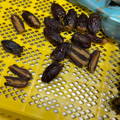
Peanuts
Family owned peanut farm using natural and sustainable practices.
- 1 - Plant, Grow, Harvest
- 2 - Shell
- 3 - Roast
- 4- Grind, Pack
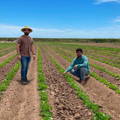
Our farmers in Mexico use the best agricultural practices to sustainably cultivate peanuts.
The farm uses natural rainfall as the primary irrigation system to ensure a pure and sustainable source. In the case of drought, there are nearby reservoirs and water supplies that allow the farm to guarantee consistent production.
Since peanuts are legumes, not nuts, the peanuts grow below ground, but actually flower above ground. Once they are harvested, they are left to dry for several days.
After harvesting, the peanut vines are left in the field to nourish the soil or be used as nutritious livestock feed.
The peanuts are carefully cleaned to remove any debris and prepared for the shelling process.
The peanuts are shelled to remove the outer layer and reveal the edible nut inside. This is done using traditional methods that involve cracking the shells with a mechanical sheller. Our farmers ensure that the peanuts are not damaged during this process to maintain their quality.


The shelled peanuts are roasted to enhance their flavor and aroma. The farmers use a slow roasting process to ensure that the peanuts are evenly roasted and not burnt.
This also helps to remove any excess moisture from the peanuts, which is essential for making peanut butter.
The roasted peanuts are ground into a smooth paste, adding only a pinch of minimally processed sea salt to enhance the flavor. The sea salt is extracted from the nearby Sea of Cortes only 75 miles away.
The freshly grinded peanut butter is packaged directly into the final container and ready to ship.
The final result? A delicious and nutritious peanut butter that was sustainably crafted all within 200 miles of the farm where it was grown.

Almonds
Family owned farms with an emphasis on regeneration and bee-health.
- 1 - Plant, Grow
- 2 - Shake, Sweep, Harvest
- 3 - Roast
- 4- Grind, Pack
- 5 - Regenerate

Our almonds come from family farms that have over 1,000 acres preserved under land conservation easements which guarantees fertile farmland will continue to provide wholesome nutrition for generations to come.
These farms use extremely efficient micro and solar powered irrigation systems to encourage sustainable practices and maximize the crop to drop ratio. They combine this with a sophisticated Hortau field management system with real time data on soil, moisture and weather meters to provide precise irrigation to eliminate water waste.
As a certified Bee-Friendly Farm and a member of the Pollinator Partnership, the farm is committed to raising bee-health awareness and protecting our pollinators through sustainable agricultural practices.
Almonds are actually a stone fruit with an outer shell, and the almond as we know it is the seed or "kernel". After being planted, the almonds grow from a tree and can take 3-4 years for a commercially viable almond crop to take.
The almond season starts in late October after the prior years harvest and begins to bloom in mid February/March. During the bloom, the almond trees look like a Cherry Blossom tree with their light pink flowers.
Bees are then brought in to pollinate the flower and begin producing the fruit (almonds). Around August, the almonds are harvested with mechanical tree shakers, sweepers and harvesters.
Once the almonds are collected, they are then hulled to remove the outer shell. The hulls are often upcycled to other farmers as cow feed given its high nutrient content.


The shelled almonds are then transferred to be cleaned and sorted to prepare for a light and slow roast.
Roasting emphasizes the natural attributes of almonds — deepening the flavor and color profile which translates to the final almond butter after grinding.
The roasted almonds are ground into a smooth paste, adding only a pinch of minimally processed sea salt to enhance the flavor. The sea salt is extracted from the nearby Sea of Cortes only 75 miles away.
The final result is a nutrient-dense roasted almond butter that taste rich and complex, yet created from only two simple and real superfood ingredients - almonds and sea salt.


Soil health is key to the long-term viability of all food crops - including almonds. The farm integrates a variety of soil health practices that center around the conservation and rehabilitation of land through regenerative practices, which includes grazing sheep in the orchard and using cover crops, to improve soil health.
We support holistic, and regenerative farming could be the key to helping the long-term viability of food crops, sequestering carbon, conserving water and improving biodiversity.
Cacao
Multiple family farms that work together to ensure supportive working conditions.
- 1 - Plant, Grow, Harvest
- 2 - Ferment/Dry, Roast
- 3 - Crush
- 4- Blend

Our cacao farmers are growing in Mexico - the place where cacao originated. The Olmecs, the first major civilization in Mexico, passed down their recipes to The Mayans and Aztecs and these are the lands our farmers use today.
Most cacao comes from Africa, where the industry can be complicated with corruption. It’s ensured that these Mexican family-owned farms are all paid fairly for their crops, and are working in supportive conditions that are 100% slave free and free of child labor.
It takes about 5 years (from seed) for a cacao tree to grow mature and start producing cacao pods with the average tree producing about 30-40 pods per year. There are many different flavors and varieties of cacao - similar to wine!
The cacao fruit is hulled, and the beans are removed from their slippery white shell. Inside, the dark bean is then exposed to oxygen, where the fermentation process can begin.
Once fermented, the beans are naturally dried in sunlight for many days and develops the richness flavor profile during this time.
The cacao beans are then roasted to remove the final outer husk (shell) of the bean to reveal the cacao nib. The roasting process also removes liquid, bacteria and further develops the flavor.


Then, the raw cacao beans are crushed into smaller nibs and eventually into a a liquid which quickly solidifies at room temperature, and the result is 100% pure cacao paste.
Because no heat is used in this process, the cacao paste retains its natural properties and nutrition. No additives or sweeteners are included, as we use 100% cacao paste.
The paste is now ready to be added to our nut butters in a facility nearby!
Our fresh cacao paste is then carefully mixed in with our natural peanut butter along with pinch of minimally processed sea salt to enhance the flavor. The sea salt is extracted from the nearby Sea of Cortes only 75 miles away.
This creates a final product that has the deep richness flavor of 100% pure cacao, the savoriness of peanut butter and a pinch of sea salt to allow all flavors to come alive!

Strawberries
Certified organic and slowly freeze-dried to keep maximum nutrients.
- 1 - Farm, Cultivate, Manage
- 2 - Harvest, Grade
- 3 - Clean, Pre-Freeze
- 4- Freeze-Dry
- 5 - Mill, Pack, Mix

Our certified Organic strawberries come from farmland that is far away from sources of pollution. Since conventional strawberries are often heavily sprayed with pesticides, we are proud to say that chemical fertilizers, pesticides, and growth regulators are prohibited.
The farmers apply organic compost, manure, or plant-based fertilizers and pest control and disease relies on physical, biological or natural measures.Irrigation must use clean water sources.
Strawberries are best grown on raised beds to keep good airflow and well-drained soil which helps prevent disease and keeps berries dry. This also allows the bees to pollinate (a crucial step) for full evenly shaped berries!
A little controlled stress (less water near harvest) can actually make strawberries sweeter by concentrating sugars.
It takes about 60–90 days from planting a young strawberry plant to harvesting ripe fruit. Flowers usually appear 3–4 weeks after planting.
Once a flower is pollinated, the berry ripens in about 30 days.
Our strawberries are hand-picked at natural ripeness to avoid mechanical damage.They maintain hygienic handling and use food-grade harvesting containers.
During the grading process, the farmers remove unripe, damaged, rotten, or moldy berries.They're graded by size, color and shape.

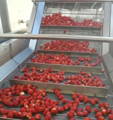
The strawberries are washed with clean running water or ozone water to help to help with sanitization.
The clean strawberries are then taken into a quick pre-freeze at -31°F to -49° F (-35°C to -45°C) which locks in nutrients, color and aroma at it's freshet point.
The frozen product is then freeze-dried, which is one of the best way to retain the nutrients of a product. In our freeze-drying process, strawberries are dried at low temperatures, allowing moisture to sublimate directly from ice to vapor—preserving their natural color, flavor, and nutrients. the end result is 100% organic strawberries - nothing else.
It's important to note the differences in freeze-dried vs spray-dried and drum-dried. Items that are spray-dried us fruit purée or juice that is sprayed into hot air and often requires a mixing carrier like maltodextrin.
With drum-dried, purée is spread on heated rotating drums and scraped off after water has evaporated out of it. Both spray-dried and drum-dried use excessive heat which removes the vitamins and flavor in the product.
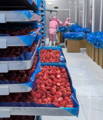
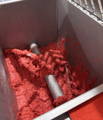
The freeze-dried strawberries are then taken to a low-temperature mill using equipment that avoids metal contamination.
They are blended and sieved to a fine powder that is then mixed into our nut butter to make an incredibly nutrient-dense and flavorful filling that taste like a guilt-free peanut butter & jelly!
